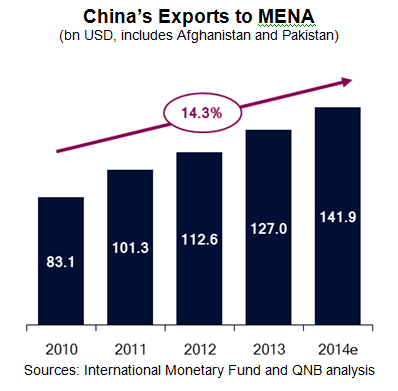The Qatar Central Bank last Tuesday celebrated the official opening of the first Renminbi Clearance Centre (RCC) in the MENA region, to be located in Doha. The RCC will allow for claims denominated in Chinese (Renminbi) to be settled in Doha and exchanged for other currencies, including the Qatari Riyal (QAR). This represents a further step in trade and financial integration between China and Qatar, two of the fastest growing economies in the world. It will also further strengthen Qatar’s role as a financial centre for the MENA region and beyond.
China became the largest exporter to the MENA region in 2014. Its exports to the MENA region grew by a compound annual growth rate of 14.3% over the last five years to an estimated USD141.9bn in 2014. Chinese exports now represent over 13% of all goods exported to the MENA region. This share is likely to continue growing rapidly as China further strengthens its role as the world’s main manufacturing hub in the coming years (see our QNB China Economic Insight 2015 report).

In light of its growing role in the world economy, China has sought to internationalise the use of its currency since the global financial crisis of 2008-09 in order to reduce dependence on the US dollar (USD). Internationalising the RMB has three main advantages. First, it reduces the cost of financial transactions by enabling direct exchange of RMB claims with non-USD currencies. Second, it increases the demand for RMB-denominated assets around the world as financial institutions hold more RMB liquidity. Third, as more and more trade is denominated in RMB, it reduces the need for the Chinese central bank to hold international reserves in USD. In fact, while China’s international reserves have nearly doubled since end-2008 to USD3.8tn at end-2014, the share held in US Treasury bonds has fallen by five percentage points to 32.6% during the same period.
The RMB internationalisation has made significant progress since it was launched in 2008. According to SWIFT, the RMB is now the second most used currency in the world in trade finance and the fifth in global payments. The RMB is also the ninth most important currency in the global foreign exchange market as measured by the Bank for International Settlements. These rankings are likely to rise with the increasing dominance of the RMB in settlements and invoicing.
This significant increase in the international use of the RMB has been achieved in part through bilateral swap agreements between the Chinese central bank and 28 other central banks around the world for a total of RMB3.1tn (about USD508bn). These agreements allow the RMB to be used outside China for settling trade and investments denominated in RMB as well as to create RMB-denominated assets. The Qatar Central Bank signed one of these bilateral swap agreements last November for RMB35bn. This agreement enables the growing trade between China and Qatar to be denominated in RMB.
In addition to the bilateral swap agreements, China has recently increased the number of RCCs in the world in order for RMB claims to be settled through selected Chinese clearing banks. Prior to 2014, RCCs were only available in a few cities in Asia such as Hong Kong, Macau, Singapore and Taipei. Since then, new RCCs have been opened in Frankfurt, London, Luxembourg, Paris, Toronto and Sydney. The latest RCC was opened last week in Doha through the Qatar branch of the Industrial and Commercial Bank of China. This RCC will enable claims from the MENA region and beyond to be settled in Doha, thus making Qatar a key financial centre for financial flows denominated in RMB.
Looking ahead, the RMB internationalisation is likely to be further boosted in 2015 by the capital account and exchange rate liberalisation in China and the potential inclusion of the RMB in the basket for the IMF currency, the Special Drawing Rights (SDR). The Chinese authorities have already increased the quotas for foreign institutional investors to buy domestic RMB-assets and have cross-linked shares between the Hong Kong and Shanghai stock exchanges.
Further measures to liberalise capital account transactions are likely to materialise in the coming months. In addition, a further widening of the exchange rate trading band linking the RMB to the USD is likely in 2015, together with a full convertibility of the Chinese currency. Finally, the IMF is expected to consider including the RMB in the SDR basket in late 2015. The SDR basket currently comprises the British pound, the euro, the Japanese yen and the USD. If the RMB is included, it would officially sanction the role of the Chinese currency as a major player in global finance.
The benefit for Qatar from the launch of the RCC last week will be threefold. First, it will further strengthen Qatar as a global financial centre. Second, it will deepen the linkages with China and the rest of Asia. Third, it will enable the offering of a series of new financial products denominated in RMB, including for Qatari investors. The RCC in Doha therefore represents another important step in financial partnership for economic growth between China and Qatar.
